Are Bifocals and Reading Glasses the Same?
Eyeglasses are more popular now than ever. They're a staple in mod fashion despite advances in contacts and vision correction surgery. Even people with perfect vision are calculation non-prescription eyewear into their wardrobe.
With then many different frames, lenses, and treatments available, picking a new pair of spectacles tin be overwhelming. This guide volition explain all the different types of glasses available.
Types of Eyeglasses
Before y'all outset shopping for new spectacles, it's essential to visit your eye md. Schedule an eye examination and determine what blazon of vision correction you need.
Your optometrist will write you an eyeglass prescription. Y'all tin use this to visit an optician or store online for your new glasses.
Prescription Spectacles
Unmarried Vision

Single vision lenses are the cheapest and about common type of eyeglass lenses. They have the largest field of vision because they merely correct vision at one specific distance (either far or almost).
If you lot are nearsighted, farsighted, or have astigmatism, you lot'll virtually likely be prescribed single vision lenses.
Bifocals

Bifocal lenses are multifocal, pregnant they have ii different "powers" in them. These unlike sections of the lens correct altitude vision and nearly vision.
Bifocal lenses are prescribed for people with multiple vision problems.
Trifocals
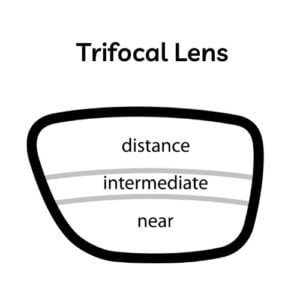
Trifocal lenses are like to bifocals. But they have an additional power to correct intermediate vision. The intermediate portion may be used to view a figurer screen, for example.
The chief shortcoming of bifocals and trifocals is that they accept a distinct line between each field of vision. This makes the sections of the lens produce drastically different vision. Most people get used to this and don't have an issue. But this drawback has led to the development of more advanced lenses, such as progressives.
Progressives

Progressive lenses work for anyone who needs bifocals or trifocals. They provide the same correction for most, intermediate, and distance vision. They practice this without the lines between each section.
Many people prefer these lenses because the transition between fields of vision is smoother.
Other Types of Glasses (Non-Prescription)
Non-prescription glasses serve a variety of functions, including preventative eye intendance, safety, and fashion.
Reading Glasses
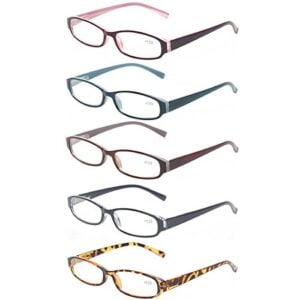
Reading glasses are available over-the-counter (OTC) or via prescription. They meliorate your ability to see things up shut, especially when reading books, newspapers, laptops, and phone screens.
OTC reading glasses work well for people with the aforementioned vision in each eye and practiced distance vision. These come in strengths from +ane.0 to +4.0.
If y'all are suffering from digital centre strain, double vision, or getting headaches from your reading spectacles, get an eye exam and see if you need prescription glasses.
Digital Protection (Bluish Light Blocking)

Blue calorie-free glasses, as well called computer spectacles, are becoming more and more popular. Particularly among the millennial generation.
Near adults spend a pregnant portion of their twenty-four hours on their computers, phones, and tablets. These glasses can help protect your eyes and improve your slumber schedule.
Safety Glasses
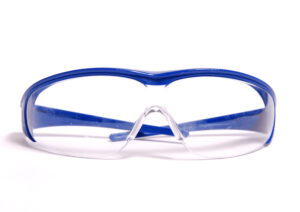
Many professions use rubber glasses, including construction, science labs, electrical piece of work, plumbing, auto repair, and more. They can exist purchased very cheaply for basic protection.
If yous need vision correction, you tin can get goggles that fit over your regular glasses or buy prescription rubber glasses. They tin exist fitted with the same lenses and treatments as regular frames.
Sunglasses

Yous can purchase sunglasses with or without a prescription. They can take polarized lenses, or UV protection handling.
Non-Prescription (Fake) Glasses

There has been an increase in popularity in non-prescription glasses recently. These are mainly manner accessories. Withal, they may as well serve as rubber glasses in certain depression-run a risk situations.
Types of Lenses and Lens Treatments
As well the standard prescriptions, at that place are a diverseness of lens options when choosing your spectacles.
Glass Lenses
Glass lenses provide first-class visual acuity. Nevertheless, they are very heavy and prone to slap-up and shattering. Their substantial weight and potential safety bug take acquired them to go unpopular. They are even so available, merely about lenses are made of some blazon of plastic now.
Plastic Lenses
About lenses these days are fabricated out of plastic because they can produce similar results to glass. Plastic is cheaper, lighter, and safer than glass.
High-Index Plastic Lenses
High-index plastic lenses are fifty-fifty thinner and lighter than most plastic lenses.
Polycarbonate and Trivex Lenses
Polycarbonate plastic lenses are standard in prophylactic spectacles, sports goggles, and children's eyewear. They are lightweight and affect-resistant, making them much less probable to cleft or shatter.
Similarly, Trivex is a lightweight and durable plastic that can be used in high-risk environments. These lenses are also thinner than bones plastic lenses, simply non equally thin and lightweight as loftier-index lenses.
Aspheric Lenses
Aspheric lenses are flatter and thinner. This makes them a great selection for stronger prescriptions that demand thicker lenses. They also reduce unwanted magnification of the wearer's optics. They may besides increase visual acuity in some cases.
High-Definition Lenses
Some companies use estimator-controlled surfacing engineering to create costless-form or wavefront lenses. These tin take your visual acuity to the side by side level. These will be much more expensive than traditional lenses.
Photochromatic (Transition) Lenses
Photochromatic lenses, commonly known as Transitions, are a popular option. They darken when they are exposed to UV rays, which eliminates the need for sunglasses. They are available in all prescription lens types.
Scratch-Resistant Coating
Applying a clear scratch-resistant coating to the front and dorsum of lenses increases their immovability. Most modern lenses come with scratch-resistance born. If yours don't, y'all tin usually add information technology for a modest additional cost.
Anti-Reflective Coating
Anti-reflective coating, also called AR coating or anti-glare coating, eliminates reflections from your lenses. This increases comfort and visibility, especially when driving, reading, or using a screen at dark. Information technology also makes your lenses nearly invisible and so that others can see your eyes through your lenses.
Anti-Fog Coating
Anyone with spectacles in a cold climate is familiar with the fogging that happens to your lenses. Anti-fog blanket can help eliminate this effect. There are permanent anti-fog treatments available, as well every bit weekly drops to treat your lenses yourself.
UV-Blocking Lens Handling
Call back of this as sunblock for your eyeballs. Adding a UV-blocking dye to your lenses will reduce the number of UV rays that attain your eyes. UV light contributes to the evolution of cataracts.
Types of Glasses Frames
Choosing the right eyeglass frames is very of import. You lot should find a pair that fits your lifestyle, is comfy for long-term vesture, and expresses your personal fashion.
Frame Materials
At that place are two principal types of cloth used to brand glasses frames:
Plastic Frames

Manufacturers utilize several types of plastic to brand frames, including zylonite, nylon blends, and castor seed oil.
Pros
- Variety of colors
- Hypoallergenic
- Lower cost
Cons
- Less durable
- Color can fade
Metallic Frames

There are many different metals used to make glasses frames including:
- Monel
- Titanium
- Beryllium
- Stainless steel
- Flexon
- Aluminum
The price of metal frames varies depending on the cloth used. They can price the aforementioned as plastic frames or reach double to triple the price.
Pros
- Durable
- Lightweight
- Corrosion-resistant
Cons
- Can be more expensive
- Tin can have negative skin reactions
- Fewer colors to choose from
Frame Types
There are three types of frames:
Full Frame

Full frames completely outline the lens. They are the about durable frame blazon, and we recommend them for thick lenses.
Semi-rimless Frame

Semi-rimless frames cover the peak portion of the lens. They are lighter and more comfortable just expose the lens to chips and cracks.
Rimless Frame

Rimless frames provide the largest field of vision and are the most lightweight pick. However, they are more frail than other frames.
Best Frame Shapes for Your Confront Shape
1 of the all-time ways to narrow downward your frame options is to decide what face shape you take. Here are the seven basic face up shapes and what frames usually go well with them.
Circular Face Shape

Circular faces accept a circular appearance with no strong edges or angles. Your face is brusque, with your cheekbones being the widest function. Frames with abrupt angles will help balance out your features.
Ideal Frame Types:
- Rectangle
- Browline
- Clear nose bridge
- Bold colors
All-time Glasses for Round Confront Shape
Heart-Shaped Face

A heart-shaped face up has a broader brow, prominent cheekbones, and a narrow mentum. Round frames help soften angles, while rectangular frames, or frames that are wider at the bottom, tin add residual.
Ideal Frame Types:
- Round
- Geometric
- Frameless
Best Glasses for Heart Shaped Face Shape
Square Face Shape

A square face shape has a like height and length. Yous have a wide, angular jaw and a broad forehead. Rounded shapes that are wider at the top will complement your face shape and add softness. Oval and rectangular frames volition add balance and structure.
Platonic Frame Types:
- Circular
- Browline
- True cat-eye
- Oval
- Rectangle
Best Glasses for Square Face Shape
Oval Confront Shape

An oval face up shape has balanced proportions. Your cheekbones are wider than your brow, you have no precipitous angles on your jaw or chin. And your face up is longer than it is wide. Frames that are only as broad or wider than your cheekbones will help maintain your natural residual.
Platonic Frame Types:
- Rectangle
- Square
- Oval
All-time Sunglasses for Oval Faces
Oblong Face Shape

An oblong face up shape is longer than information technology is wide, similar to an oval shape. The departure is an oblong face up shape has a long, straight cheek line. Thick, angular frames volition balance the round features.
Ideal Frame Types:
- Square
- Rectangle
- Wayfarer
- Oversized
Diamond Face Shape

Diamond-shaped faces are the rarest. They have narrow, angular jaw lines, prominent cheekbones, and narrow foreheads. Rounded frames will add softness and remainder.
Ideal Frame Types:
- Browline
- Cat-center
- Round
- Aviator
Base-down Triangle Confront Shape
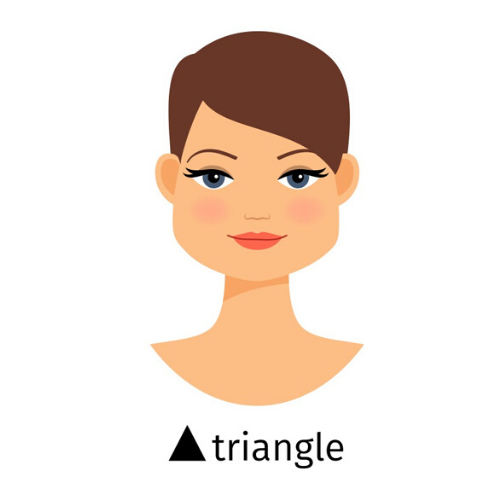
A base-downward triangular face has a broad jawline, broad cheeks, and a narrow forehead. Glasses with a wider top rim help to remainder features.
Platonic Frame Types:
- Browline
- Cat-centre
- Aviator
- Wayfarer
If you're interested in contacts, LASIK, or other center surgeries, find out more.
Eyeglasses FAQs
What are the different types of glasses?
The primary types of glasses are single vision (monovision), bifocals, trifocals, progressives, toric lenses, and prism lenses.
What are the different types of frames?
The three chief categories of eyeglass frames are full-frame, semi-rimless, and rimless glasses. They can be made from metal or plastic and come up in a variety of shapes, sizes and colors.
What type of lenses are there for glasses?
The principal types of lenses used for vision correction are unmarried vision (monovision), bifocals, trifocals, progressives, toric lenses, and prism lenses.
Best Places to Buy Glasses
Best Overall
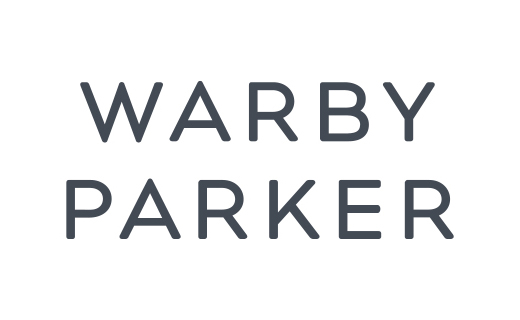
Warby Parker has stylish, loftier-quality frames at affordable prices.
Also Great

Liingo Eyewear is another great option to purchase glasses online.
Best on a Budget

EyeBuyDirect has a wide variety of upkeep frames starting at $six.
Best Places to Purchase Contacts
Best Overall

1-800 Contacts is our #1 recommendation to buy contacts online.
Besides Groovy

GlassesUSA has a huge selection of contacts, glasses, & sunglasses.
Source: https://www.visioncenter.org/eyeglasses/
0 Response to "Are Bifocals and Reading Glasses the Same?"
Post a Comment